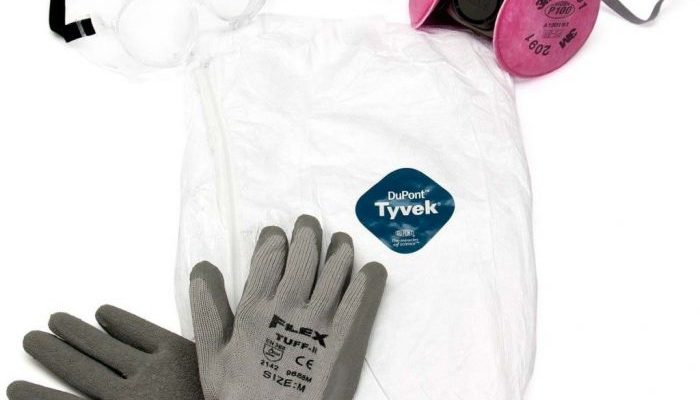We can all agree that both you and your family’s safety is most important when considering taking on a property restoration project. However, this is one aspect that is largely overlooked by the amateur restorer.
So before you start your project you should assess the situation and think of what safety gear you may need; more commonly referred to as PPE (personal protective equipment).
Every different restoration project will have a different set of PPE that should be considered. For example, a simple drywall and painting project may require only minimum PPE such as a dust mask and eye protection, but more involved property restoration projects such as a Category-3 water damage loss would require you equip a much more serious set of PPE.
Some examples of PPE include:
- Hard hat
- Goggles
- Rubber boots/ Steel toe boots with protective shanks
- Protective Clothing such as a Tyvek Suit
- Gloves that are chemical resistant
- Respirator
The appropriate set of PPE required really depends on what kind of property restoration project you are taking on. Improper assessment and use of PPE could lead to personal harm, effects of which may not be seen immediately. For example, open cuts and sores could become infected if exposed to contamination while inhalation of toxic fumes and particles can cause illness. Lastly we need to protect ourselves from more obvious hazards such as falling objects and electrical shock.
So please, take the time to properly assess your restoration project and think of what PPE you may require. The more specialized the project the higher the chances that you will need specialized PPE.
If you are considering taking on a property restoration project that contains contaminants such as sewage or microbial growth then take a look at my breathing in clean air post as it will help you determine which respirator is right for the job.
Hazards In Your Home During A DIY Project
 Alright so you want to start a restoration project in your home, you have gathered all the tools and materials needed and are eager to get going. But before starting you should be aware of any possible hazards that may be involved in the process.
Alright so you want to start a restoration project in your home, you have gathered all the tools and materials needed and are eager to get going. But before starting you should be aware of any possible hazards that may be involved in the process.
What do you mean hazards? “It’s my home I live here and its safe…”
Well yes, for the most part, you are correct, but taking on repair projects in your home does involve some risk. As you can see in the above image, this home has suffered severe water damage from a large rain storm. Water leaked through the roof and pooled up in the ceiling. Eventually, the weight of the water caused the ceiling to collapse, with its lighting fixtures were damaged and broken exposing live electrical wires.
So you get the point, depending on what it is you are taking on there may be some associated risks involved.
The following is a list of some potential hazards that could be present when you are taking on a property restoration project:
- Collapsing Ceilings and Falling Objects – if your property has suffered from water damage and water from the upper floor leaked down into the lower floor there could be a risk that there is water trapped within the ceiling. The weight of this water could cause the ceiling to suddenly collapse.
- Asbestos and Lead – mainly found in older homes, you should be aware that paint and drywall compounds could contain traces of lead and asbestos.
- Mould can be found virtually anywhere within your home so long as the right conditions are present to sustain mould growth.
- Crawlspaces and Confined spaces – limited space for movement, unstable atmospheric levels, exposed building materials such as nails, the possible presence of toxic gases and materials.
- Chemicals – inappropriate storage and handling of chemicals could cause harm.
- Electrical – exposed wiring could cause shock and fires.
And the list goes on, but you get the idea. Hopefully reading this has at least given you some awareness regarding hazards in your home and has you thinking about the safety of you and your family.

